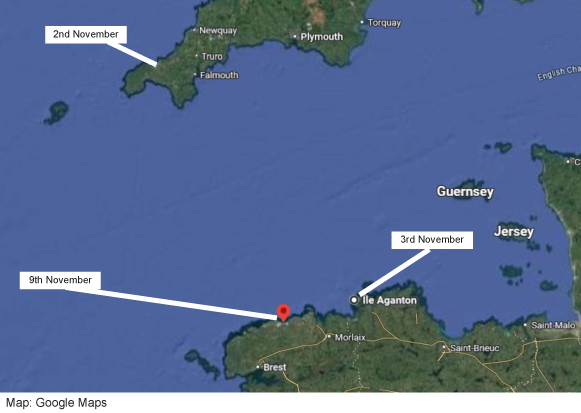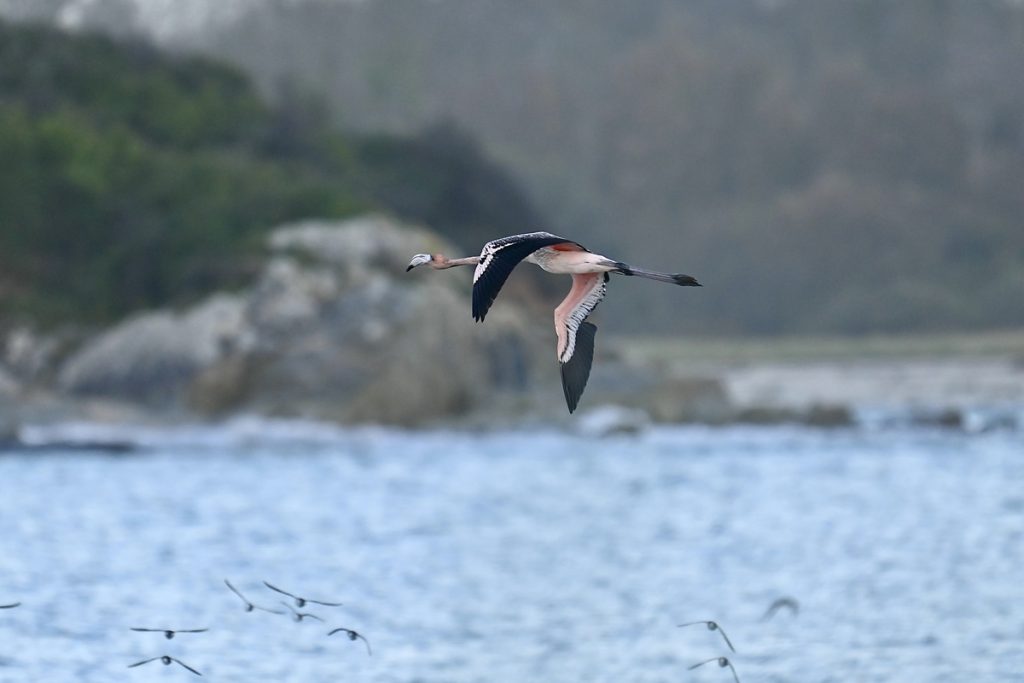Update on Flamingo ‘Frankie’, 12th November 2025
By Curator David Woolcock, Paradise Park Wildlife Sanctuary
All of us at Paradise Park would like to express our sincerest thanks to the public, and both the local and national media for their assistance in the search for Flamingo Frankie.
When Frankie left our site on the morning of Sunday 2nd November, sometime between 8am and 8:20am, we were devastated. Immediately we began searching for her and informed the media asking for their assistance. One confirmed video sighting on Sunday 2nd showed Frankie flying high and strong over the Hayle Estuary area. Further sightings were reported to us over the coming days, none of which could be confirmed. In addition, there was also a White Stork in the area which added to the possible sightings.
However, we now know that by 9.49am on Monday 3rd November Frankie was already at the Île Aganton, on the north coast of France! This sighting was reported on the French national citizen science portal for nature. This all became apparent on 9th November when a further set of photographs of Frankie looking fit and well, and who was now along the coast at Plage de Keremma, were forwarded to us.
Below: Photograph taken at Plage de Keremma, Finistere, Brittany, France sent through on 9th November courtesy of Alice Beddows.


Between 2nd and 9th November Park staff were out at all times of the day and night, in all weathers, following up on potential leads in order to try and retrieve Frankie. When the confirmed sighting of her in France came to our attention on 9th we immediately knew it would be unlikely that we would be able to return her to the Park for the reasons shown below.
It was never our intention for Frankie to end up in the wild. There are a number of reports of similar situations where flamingos have lived for many years and thrived, including over European winters, so while we will continue to worry about her it is a position we have to accept.
We are confident that her movements will be observed and logged in France by the citizen science members and feel relieved to know that she has shown the resilience and skills that will serve her well as a “wild” flamingo. Frankie’s parents and the rest of the flock at Paradise Park continue to do well.
Below: Photo courtesy of Mickaël Belliot (also used above for the heading image). Taken on the 10th November 2025 at Goulven, near Plage de Keremma, Brittany, France.

FAQ:
Can Frankie survive in the wild, will she meet other flamingos?
Flamingos are really quite hardy creatures, sometimes flying hundreds of miles and crossing entire continents. Frankie was parent reared so no doubt learnt a lot from her parents. She was feeding independently and was a supremely fit young bird before she flew off from the Park. She has been seen with other birds which will give her some company, and all the evidence that we have seen of her in France shows a well-adjusted, well-fed bird doing extremely well. We don’t know if she will move on elsewhere, large flocks of flamingos live in southern France and to the north at Zwillbrocker Venn on the border of Netherlands and Germany. We are in touch with people in France who plan to continue their updates and will pass on any news on this page.
Why did Frankie fly away?
Frankie had the feathers on her right wing clipped. This involves shortening some of the primary & secondary feathers on one wing only, and this is short-term as the feathers regrow in full at each moult. She was at an age when she became independent of her parents and had a strong instinct to take off and explore.
How did Frankie gain flight if wing clipped?
Three things come in to play here;
Firstly, Frankie’s wing feathers were continuing to grow as she developed. On two occasions her feathers were checked and trimmed to prevent her gaining full flight.
Secondly, when feathers grow, they grow in something known as a blood quill, which looks similar to a drinking straw filled with blood. These growing feathers cannot be trimmed until the feather erupts from the blood quill sheath.
Thirdly, wing clipping inhibits the ability to take off, but not necessarily the ability to fly once airborne. Young birds, including flamingos, are often seen flapping their wings to exercise them before they are ready for their first flight. Frankie had become independent of her parents, and we suspect that it was in just such an exercise period that Frankie was caught by a gust of wind which made her airborne. Then she was on her way.
Will you go and get her back from France?
In short no. As much as we would like her to return to the Park there are numerous issues. First, we would have to catch her. Being parent reared she has a healthy wariness of people, she is not tame and is a fit young bird who has found a good feeding location.
She is now in another country. If she were to be caught in France, she would then need to be housed at a French institution to be health screened as part of the UK importation process. But it is unlikely that any would agree to hold Frankie as she has been mixing with wild birds and may have been in contact with avian influenza infected birds. And that is our biggest concern for her. Avian Influenza continues to be a major threat to wild birds, and we hope that Frankie remains safe and healthy.
You can view Frankie’s blog with more information here.
As an unplanned event, Frankie’s escape to the wild received huge interest and media coverage. However, Paradise Park Wildlife Sanctuary has worked tirelessly over decades to breed and release other birds into the wild in vital national and international conservation projects.
Examples are;
Over 60 Red-billed Choughs for reintroduction projects in Jersey and Kent where the species had been locally extinct for up to 200 years. Please click here for more information.
10 Blue-throated Macaws to Bolivia where less that 400 of the species still exist in the wild. Please click here for more information.
40 Mitchell’s Lorikeets to Bali where fewer than 4 birds remain in the wild. Please click here for more information.